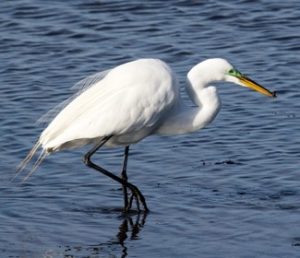Article by Dr. Christine Thompson, Assistant Professor of Marine Science, Stockton University
Recipe for an oyster reef
A lot of shell. Even more oyster larvae. A little bit of time, some food and water, and a lot of labor.
In Barnegat Bay, the eastern oyster is functionally extinct. This doesn’t mean they are extinct or even endangered, it just means that they don’t exist in the ecosystem role they were meant to play. It’s like having an evergreen forest with only a half dozen trees. It won’t provide any habitat or protection for other animals. To really bring oysters back to the bay, we need to bring back the oyster reefs.
Oysters have a complex life cycle with a microscopic larval stage that disperses with the currents for a few weeks. To metamorphose (change form) into an adult, it first needs to find a suitable place to settle. For the oyster, that means a hard surface or preferably another oyster shell. Without a huge abundance of oyster shells in the bay, oyster larvae are left to find random concrete blocks or pilings to settle onto. This won’t really make a reef.
To build an oyster reef, we need to provide substrate for the oyster larvae to adhere to. We could just dump a lot of shell into the bay and hope to catch any larvae that could settle onto them. For some places like Delaware Bay or the Gulf of Mexico, this strategy works. But even with a growing oyster aquaculture industry in Barnegat Bay, it still wouldn’t be enough to create our “forest.” For our work, we resort to a method called remote setting.

With the help and support of Dale Parsons, a local aquaculturist (shellfish farmer) and owner of Parson’s Seafood in Tuckerton, we’ve made this happen with grant funding from the Barnegat Bay Partnership. For remote setting, you essentially create a replica oyster reef on shore. At the Great Bay Marina in Little Egg Harbor, we use large fiberglass tanks crammed with cages of different shell types. The tanks get filled with water and millions of oyster larvae are added. The oyster larvae then settle onto the shell and metamorphose into juvenile oysters becoming permanently attached to the shell. After they’ve grown a little bit feeding on phytoplankton (microscopic marine algae) pumped in from the bay, they are moved out of the cages, dumped onto a barge, and moved out to the reef site.

But what about the numbers?
This year has been our largest effort to date. We had four tanks.
Each tank had 22 cages inside. Fifteen cages were oyster shell (preferred shell
for oysters), three were surf clam shell (a bigger shell), and three were whelk
shell (the biggest substrate).
Back-of-the-envelope calculations (aka counting lots and lots of shell in
bushel baskets) estimated a total 300,000 shells used in this effort. Of those
shells, about 95% were oyster shell recycled from area restaurants in an effort
funded by Long Beach Township and the JettyRock Foundation (read
more here). Each tank received 2.75 million larvae, or 11 million total.
The larvae came from Rutgers Aquaculture Innovation Center in Cape May, NJ.
The other grueling part was the effort of my team of staff and students at Stockton University to estimate the number of oysters out of the 11 million larvae that settled onto the shell. We went out on a 90 degree day and sampled shells from the cages as they were dumped on the barge. We brought over 1,000 shells back to the lab and counted every single “spat” or baby oyster that had settled onto the shell. Twice, for good measure. We counted so much we were seeing oyster spat in our sleep!

We then extrapolated this back to the amount of shell in each cage and then in each tank. Out of those 11 million larvae, 2 million settled onto the shell. Eighteen percent success-this may seem low, but our goal was to achieve greater than 5%, and we did more than three times that.
Two million may seem like a lot of oysters, but it’s small compared to the millions of oysters put out each year by much larger oyster restoration programs like the Chesapeake or Billion Oyster Project in New York City. Truth is, some are already dead because of how the shells land on the bay bottom. But those that survive will grow to provide habitat for other organisms and filter the water removing suspended sediment and excess phytoplankton that blooms from all the nutrients that enter the bay.
We will continue adding oysters to the reef and building new reefs with the hope that eventually our “forest” will fill in, and enough oyster larvae will be around to keep the reefs growing year after year, reviving the lost oyster reef ecosystem in Barnegat Bay.
Author contact: Christine.Thompson@stockton.edu


